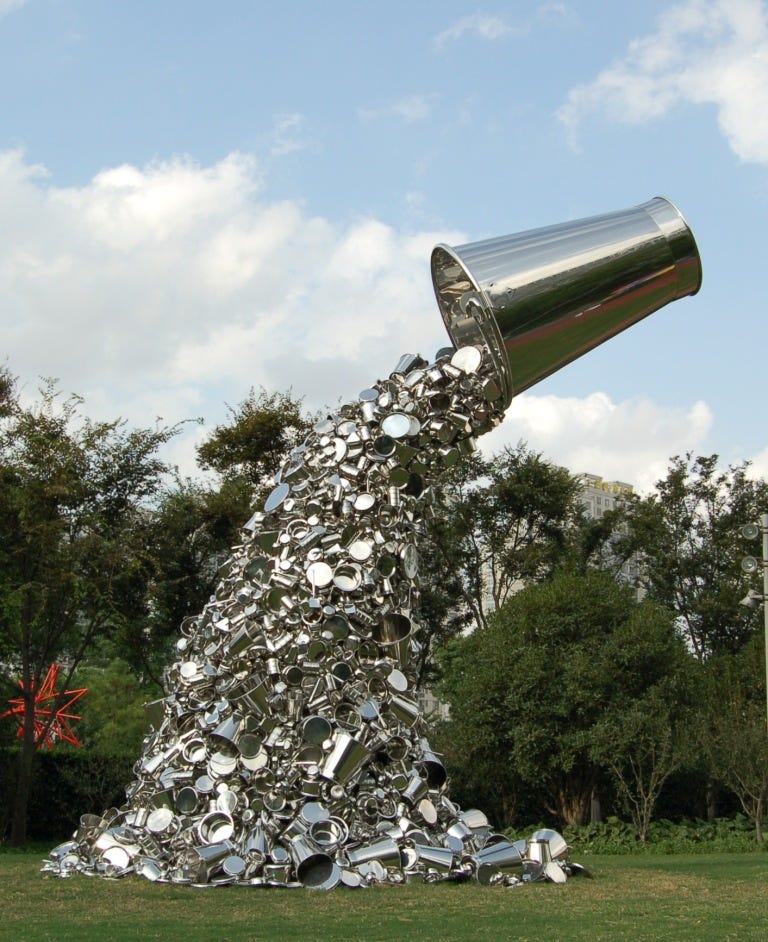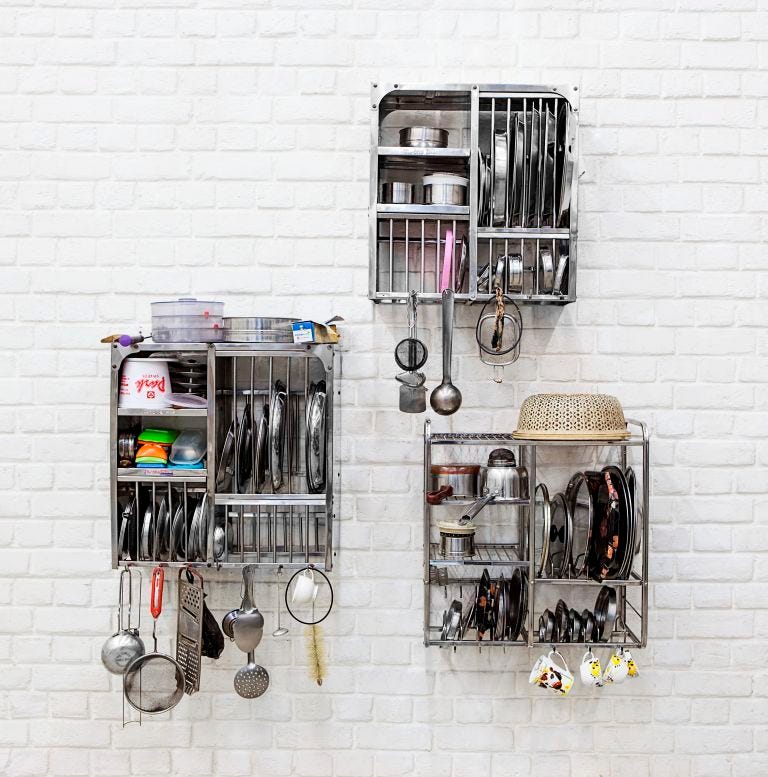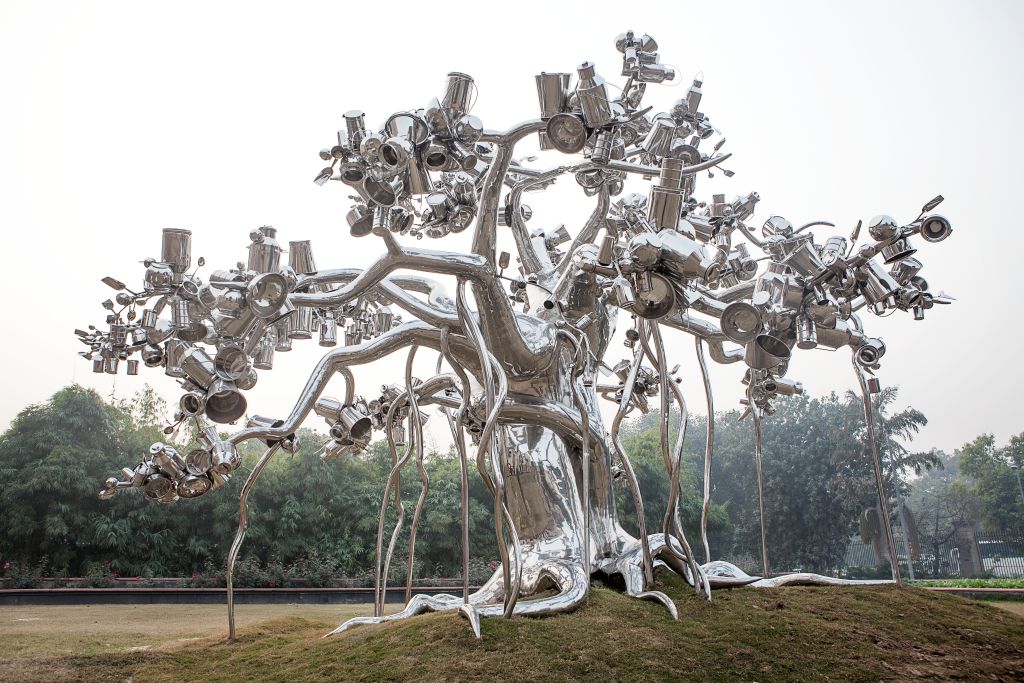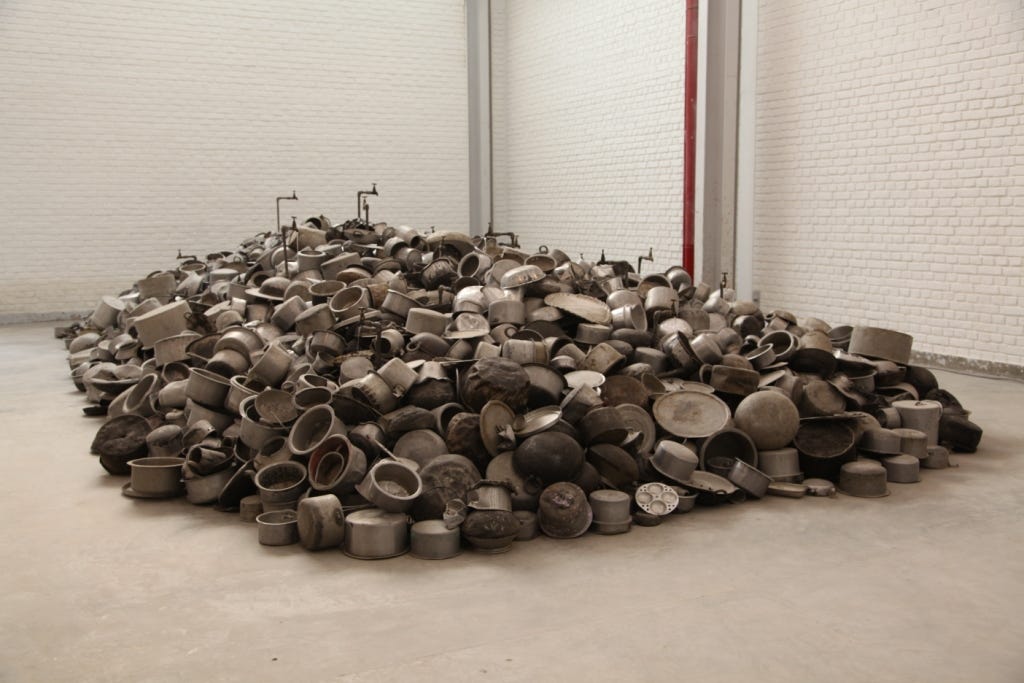
Everything is Inside | Subodh Gupta at NGMA, New Delhi, 2014
Reviewed by Habiba Insaf
An ordinary stainless steel rimmed bucket spills a cartload of shiny kitchenware and bartans onto the floor of an erstwhile Maharaja’s palace grounds. The monstrosity of the multiple fallen forms is further underscored by the gigantic tilted bucket suspended in mid air that has eerily outgrown its conventional size. The lustrousness of the material is met with the sonic imagination of a catastrophic spill. Titled “Ray” after the great Surrealist artist Man Ray, the artist creates a dialogue with the Western avant garde by bringing the language of readymades and installations home.

Ray, 2012, Stainless steel utensils, 400 x 400 x 600 cm, Image Courtesy Arario Gallery and Artist.
Known for spectacularising the mundane and monumentalising the everyday to create an arresting, threatening and sublime work of art, Subodh Gupta’s mid career retrospective at the National Gallery of Modern Art, New Delhi curated by Germano Celant exhibits a series of works never introduced to an Indian audience before. Right from his early work created at Sanskriti Residency(1995) which uses the petha/patlas (low stools) to create mixed media work mounted on the wall to the more recent Kerala fishing boat titled All in the same boat(2012) which houses old utensils and upside down long, overhead electric fans to reflect bureaucratic apathy and tedium. The exhibition’s breadth spans over three decades of Gupta’s practice.
Identity, homeland and celebration of rural nativity has been a recurrent leitmotif in Gupta’s work. Gupta whilst creating a primordial architecture of cow dung cakes as the visual signifier for the memories of his village by rubbing the very bovine defecate over his body in the lone video work Pure(1999) stirs questions about purification, discrimination and racism. Bihari(1999) celebrates his identity and homeland on cow dung smeared paper while My Family Portrait (2013) is an installation of carefully orchestrated kitchen utilities placed upon racks typical in a middle class household. The endemic violence, turmoil and the sterile economy of his state Bihar is emphasised through an installation of empty thalis, bowls and tiffins lucidly interspersed with toy revolvers presided over by white fibreglass of a bovine animal.

My Family Portrait, 2013, mixed media, variable dimensions, Ozlo Collection, Image Courtesy Ravi Ranjan.
Challenge to the materiality and form is central to Gupta’s practice. Six bronze potatoes precariously kept in a plastic bag is hung by the wall. Half knead dough cast in bronze is sprinkled with fresh flakes of wheat flour. Consumable, perishable and quotidian objects are given weightiness and permanence by casting it in bronze. Bronze and marble – the Classical choice for statues and sculptures, is used by Gupta to eulogize and museum-ize ordinary objects found in every household. By using stainless steel or ‘proletariat silver’ as Jeff Koons calls it, as his primary symbol of visual communication, the artist conflates the spectacular with the ordinary appropriating simple utilitarian objects to tell a different story.

Dada, 2010-13, stainless steel and stainless steel utensils, variable dimensions, Image Courtesy Artist, Arario Gallery and Nature Morte.
Subodh Gupta’s Dada-ist influence can be seen in the use of the readymade and the found object displaced and re-contextualised to lend a fresh perspective to the work. A surrealist banyan tree with stainless steel trunk and hanging root bears foliage and fruits in the form of stainless steel utensils of varied size. Titled DADA(2010-2013), the work is not just a reference to the eponymous avant-garde movement but by using a common Indian cultural trope of the Banyan tree the artist makes a tongue in cheek remark to the patrilinear tradition in Indian society (Dada in Hindi means grandfather.) A skull – the memento mori lies dreaming on an oversized pillow testifying to a surrealist preoccupation with death and the unconscious, often at play in his works. The brass urinal is an unmistakable ode to the legacy of Marcel Duchamp while This is not a Fountain (2013) is playfully conversant with Magritte’s iconic This is not a pipe(1948). However, Gupta is not one for easy categorisation. His influences are interspersed with pop art and minimalism infused with abstraction and design.

Mind Shuts Down, 2008, stainless steel utensils, stainless steel stand, 254 x 155 x 172 cm, Ozlo Collection, Image Courtesy The Artist.

This is not a Fountain, 2013, found aluminium utensils, water pipe, tap, cement, wire, pump and water, variable dimensions, Image Courtesy Hauser & Wirth and The Artist.
Gupta’s titles are often conceptual titillating the viewer to think beyond the immediacy of the work that surrounds them. The top of a sliced off immobile ambassador taxi is used to load two migratory labourer’s belongings packed into tight bundles made of bronze. Titled “Everything is Inside” from where the exhibition draws its name, the mystery that is contained within these bundles is emphasised just as much as is the transition, movement and liminality. A brass door installation placed against the wall creates a moment of tense anxiety between the interior and the exterior positioning the spectator in a threshold of anticipation. Be it the simplicity of a glass of water tantalisingly filled up to the brim or the cascading stainless steel utensils seen through the sophisticated mechanism of a peephole in a terracotta vase encapsulating the complex Buddhist and Hindu philosophy of the universe in a vase, Everything is Inside after all.
Everything is Inside was on view at the National Gallery of Modern Art, New Delhi till 16th March, 2014.
